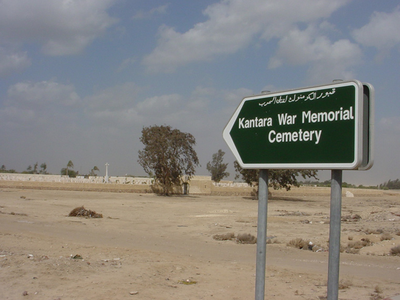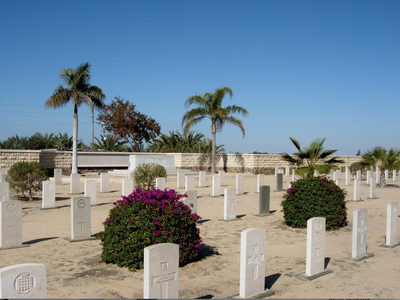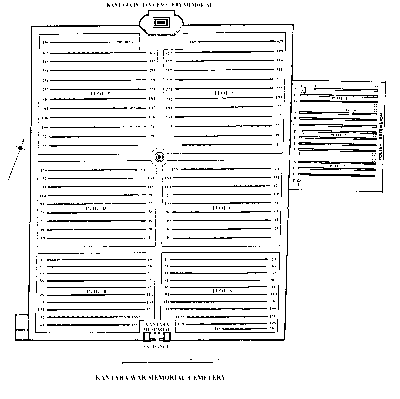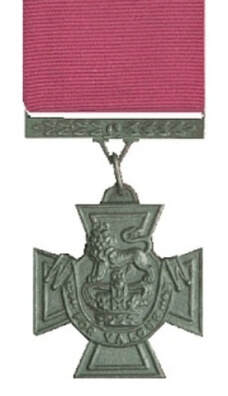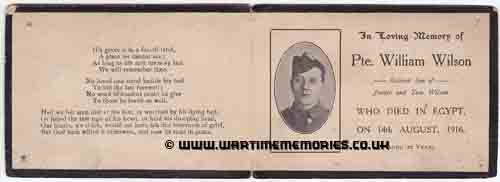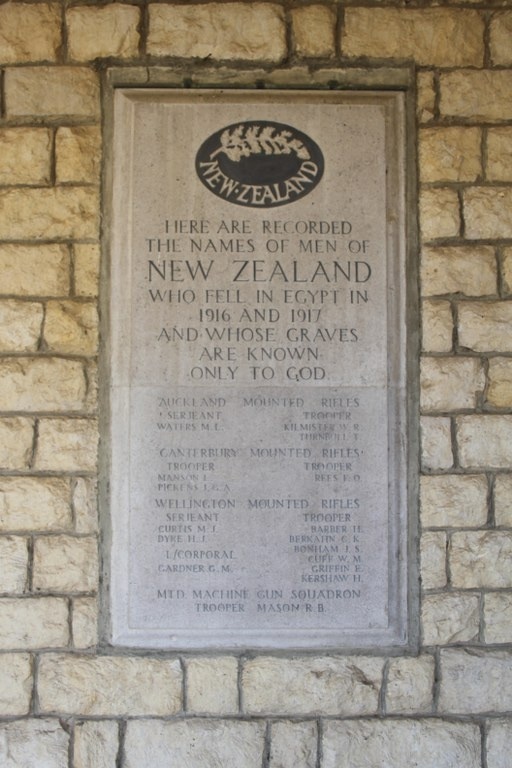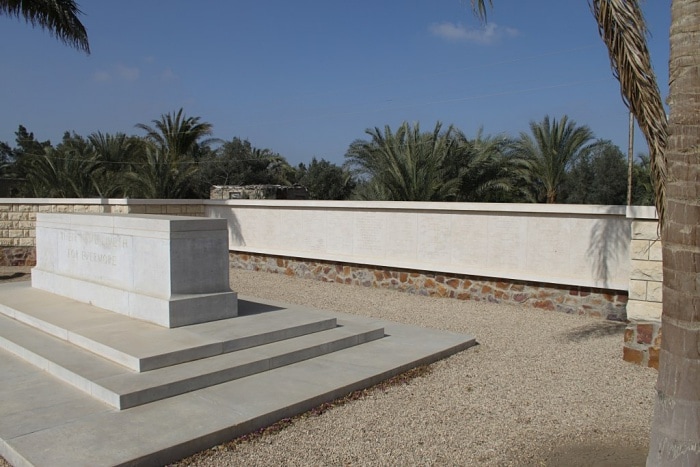KANTARA WAR MEMORIAL CEMETERY
KANTARA MEMORIAL
KANTARA INDIAN CEMETERY MEMORIAL
Kantara East
Egypt
GPS Coordinates: Latitude: 30.87194, Longitude: 32.33173
Location Information
Kantara War Memorial Cemetery is situated at Kantara East on the eastern side of the Suez Canal, 160 kilometres north-east of Cairo and 50 kilometres south of Port Said.
Access to Kantara East is via vehicular or small passenger ferry from Kantara West. Kantara East is 30 kilometres north of Ismailia on the main Ismailia-Port Said road. The cemetery is 3 kilometres by road from the ferry, on the northern outskirts of the village.
It is now possible to access the Cemetery crossing the Suez Canal Bridge. Once on the Sinai side of the bridge follow (north) the signs for Kantara. The Cemetery is located on the right side of the road (within 70 metres) as you enter the town of Kantara.
Visiting Information
Visitors are advised to consult the Foreign Commonwealth Office travel advice before considering a visit to the region due to the current unrest. For up-to-date information visit www.gov.uk/foreign-travel-advice
Opening times:
Saturday to Thursday: 7.00am to 2.30pm.
Friday: closed.
Wheelchair access to the cemetery is possible via the main entrance of the cemetery.
Please note that some of the rows in this cemetery contain later, additional burials. The grave numbers in these particular rows may not therefore relate to the actual headstone numbers on the ground, for example Grave 1a = headstone 1, Grave 1b = headstone 2 and so on.
Historical Information
In the early part of the First World War, Kantara was an important point in the defence of Suez against Turkish attacks and marked the starting point of the new railway east towards Sinai and Palestine, begun in January 1916. Kantara developed into a major base and hospital centre and the cemetery was begun in February 1916 for burials from the various hospitals, continuing in use until late 1920. After the Armistice, the cemetery was more than doubled in size when graves were brought in from other cemeteries and desert battlefields, notably those at Rumani, Qatia, El Arish and Rafa.
The Second World War again saw Kantara as a hospital centre. No 1 General Hospital was there from July 1941 to December 1945 and two others, Nos 41 and 92, were there in turn for varying periods. One of the major allied medical units in the area, No 8 Polish General Hospital, adjoined the war cemetery.
The cemetery was designed by Sir Robert Lorimer
KANTARA WAR MEMORIAL CEMETERY now contains 1,562 Commonwealth burials of the First World War and 110 from the Second World War. There are also 341 war graves of other nationalities in the cemetery, many of them made from the Polish hospital and concentrated in a distinct Polish extension.
Kantara War Memorial Cemetery
Total Burials: 2004.
World War One Identified Casualties: United Kingdom 1,139, Australia 235, New zealand 112, Germany 39, South Africa 14, India 8, Italy 2, Russia 1. Total 1,550.
World War Two Identified Casualties: Poland 258, United Kingdom 74, Greece 17, South Africa 14, Australia 13, New Zealand 7, India 2, Russia 2. Total 387.
Near the entrance to the cemetery is the KANTARA MEMORIAL, bearing the names of 16 New Zealand servicemen of the First World War who died in actions at Rumani and Rafa, and who have no known grave.
Kantara Memorial
World War One Commemorated: New Zealand 16.
In 1961, nearby Kantara Indian Cemetery became inaccessible and it was decided that the 283 First World War servicemen buried there should instead be commemorated at Kantara War Memorial Cemetery. Panels bearing the names of the dead were affixed to the wall of the cemetery behind the Stone of Remembrance, forming the KANTARA INDIAN CEMETERY MEMORIAL.
Kantara Indian Cemetery Memorial
World War One Commemorated: India 283.
Kantara War Memorial Cemetery
203329 Private Samuel Needham, V. C.
1st/5th Bn., Bedfordshire Regiment
4th November 1918, aged 33.
Plot E. 181.
Son of Septimus and Mary Needham, of Grimsby.
His headstone bears the inscription "Saviour In Thy Gracious Keeping Leave We Now Our Loved One Sleeping"
Citation:
An extract from The London Gazette, No. 30982, dated 29th Oct., 1918, records the following:-"For most conspicuous bravery and initiative when with a strong patrol which was heavily attacked by the enemy and forced back in confusion. At this critical moment Pte. Needham ran back and fired rapidly at a body of the enemy at point-blank range. His action checked the enemy and enabled the patrol commander to reorganise his men. The patrol had many casualties, but successfully got back all their wounded, and it was due to the action of individuals, of which this is the most outstanding, that the entire patrol was not cut off. Pte. Needham's example was of the greatest value at a critical moment, and the bold and determined stand made by him did more than anything to inspire confidence, and undoubtedly saved a critical situation."
Headstone
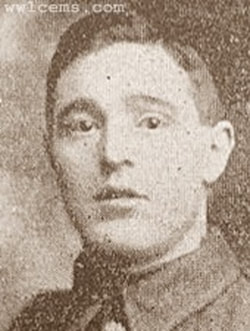
9965 Private
Ellis Beamer
229th Machine Gun Corps (Inf)
Died of Wounds 18th November 1917, aged 22.
Plot D. 93.
Son of James Ellis Beamer, of 14, Roebuck St., Burnley.
Ellis Beamer
229th Machine Gun Corps (Inf)
Died of Wounds 18th November 1917, aged 22.
Plot D. 93.
Son of James Ellis Beamer, of 14, Roebuck St., Burnley.

3517 Private
Eric William Crummett
1/5th East Lancashire Regiment
Died 2nd February 1917, aged 21.
Plot E. 383.
Son of Robert and Eva Crummett, of 86, Piccadilly Rd., Burnley.
Eric William Crummett
1/5th East Lancashire Regiment
Died 2nd February 1917, aged 21.
Plot E. 383.
Son of Robert and Eva Crummett, of 86, Piccadilly Rd., Burnley.

302801 Lance Corporal
James Finnigan
7th Royal Scots Regiment
Died of Wounds 5th June 1917, aged 25.
Plot C. 72.
Husband of Elizabeth Ellen Finnigan, of 170, Hollingreave Rd., Burnley.
James Finnigan
7th Royal Scots Regiment
Died of Wounds 5th June 1917, aged 25.
Plot C. 72.
Husband of Elizabeth Ellen Finnigan, of 170, Hollingreave Rd., Burnley.
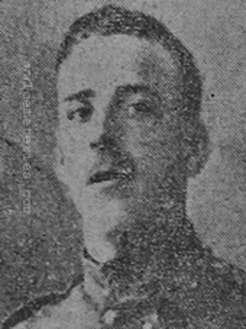
700251 Shoeing Smith
William Pate
Royal Field Artillery
Died of influenza 23rd January 1919, aged 28.
Plot E. 325.
Husband of Annie Mary Pate, of 17, Barracks Rd., Burnley.
William Pate
Royal Field Artillery
Died of influenza 23rd January 1919, aged 28.
Plot E. 325.
Husband of Annie Mary Pate, of 17, Barracks Rd., Burnley.
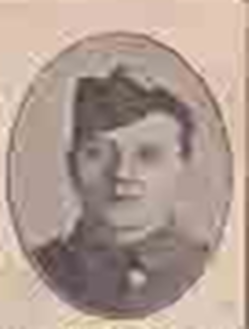
2794 Private
William Wilson
1st/7th Highland Light Infantry
14th August 1916 aged 22
William Wilson, my great uncle was born in Bridgeton, Glasgow to parents Tom and Jeannie Wilson. He was killed on 14th Aug 1916 at the age of 22 and lies in Kantara War Memorial Cemetery, Egypt. He may have been killed at The Battle of Romani. Unfortunately there are not too many living relatives left in my family with any more info.
Remembered with pride and honour from his niece Christina Derry (nee Wilson) and great nephew Robert Derry.
Information and pictures courtesy of Robert Derry (Great Nephew)
William Wilson
1st/7th Highland Light Infantry
14th August 1916 aged 22
William Wilson, my great uncle was born in Bridgeton, Glasgow to parents Tom and Jeannie Wilson. He was killed on 14th Aug 1916 at the age of 22 and lies in Kantara War Memorial Cemetery, Egypt. He may have been killed at The Battle of Romani. Unfortunately there are not too many living relatives left in my family with any more info.
Remembered with pride and honour from his niece Christina Derry (nee Wilson) and great nephew Robert Derry.
Information and pictures courtesy of Robert Derry (Great Nephew)
Shot at Dawn
4881 Private Hubert A. Clarke, 2nd Bn. British West Indies Regiment, executed for two convictions for striking a superior officer 11th August 1917. Plot D. 60. He was serving a prison sentence at Kantara when a disturbance caused the Military Police to intervene. There upon Clarke punched a sergeant in the face & knocked him to the ground with a long piece of wood; a lance-corporal who came to assist was very seriously wounded in the stomach by Clarke who was wielding a razor. A very full account of the sentenced man’s repentance & of his courage before the firing squad is at Putkowski, pp 230-231.
4881 Private Hubert A. Clarke, 2nd Bn. British West Indies Regiment, executed for two convictions for striking a superior officer 11th August 1917. Plot D. 60. He was serving a prison sentence at Kantara when a disturbance caused the Military Police to intervene. There upon Clarke punched a sergeant in the face & knocked him to the ground with a long piece of wood; a lance-corporal who came to assist was very seriously wounded in the stomach by Clarke who was wielding a razor. A very full account of the sentenced man’s repentance & of his courage before the firing squad is at Putkowski, pp 230-231.
The above image, courtesy of Tony Emptage at "Shot at Dawn" photos. More information can be found on "Shot at Dawn burials" by clicking here


